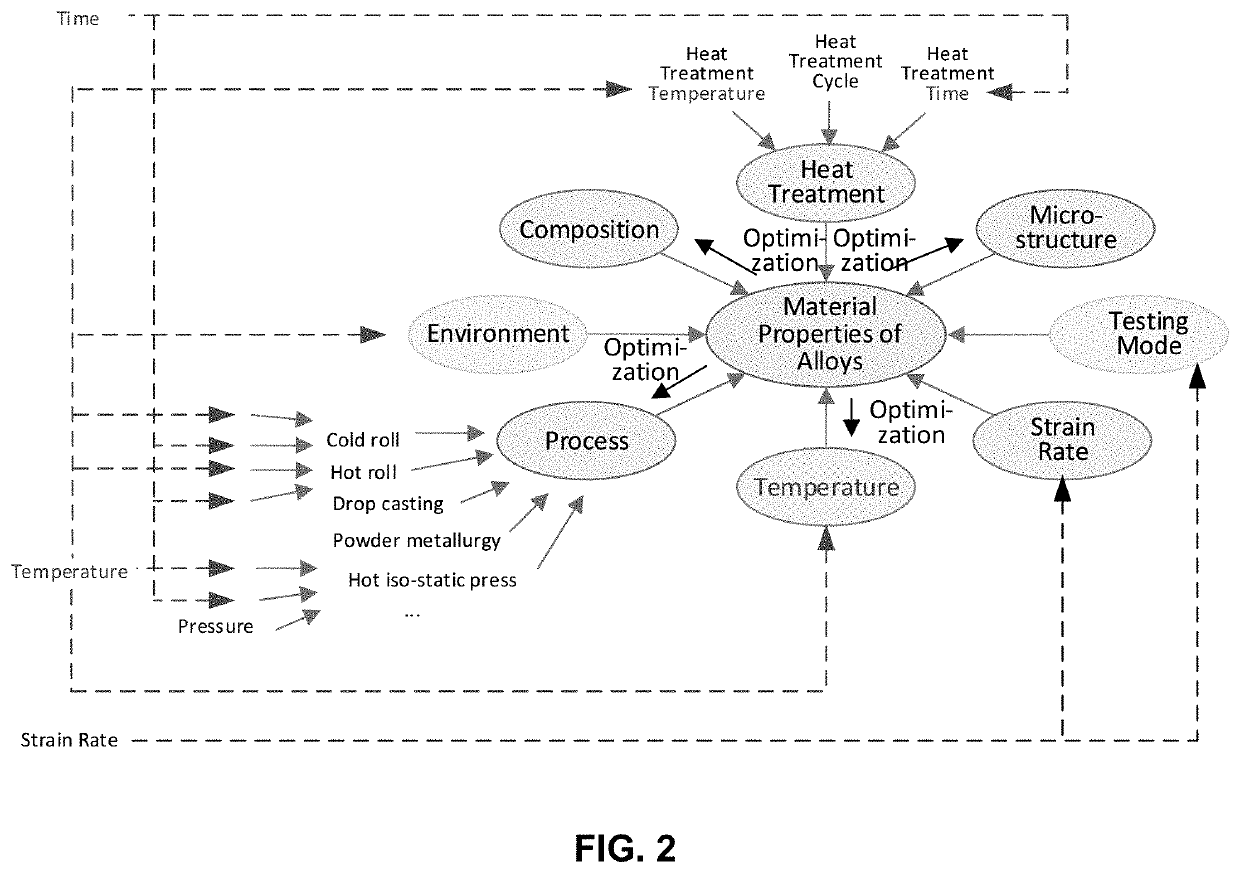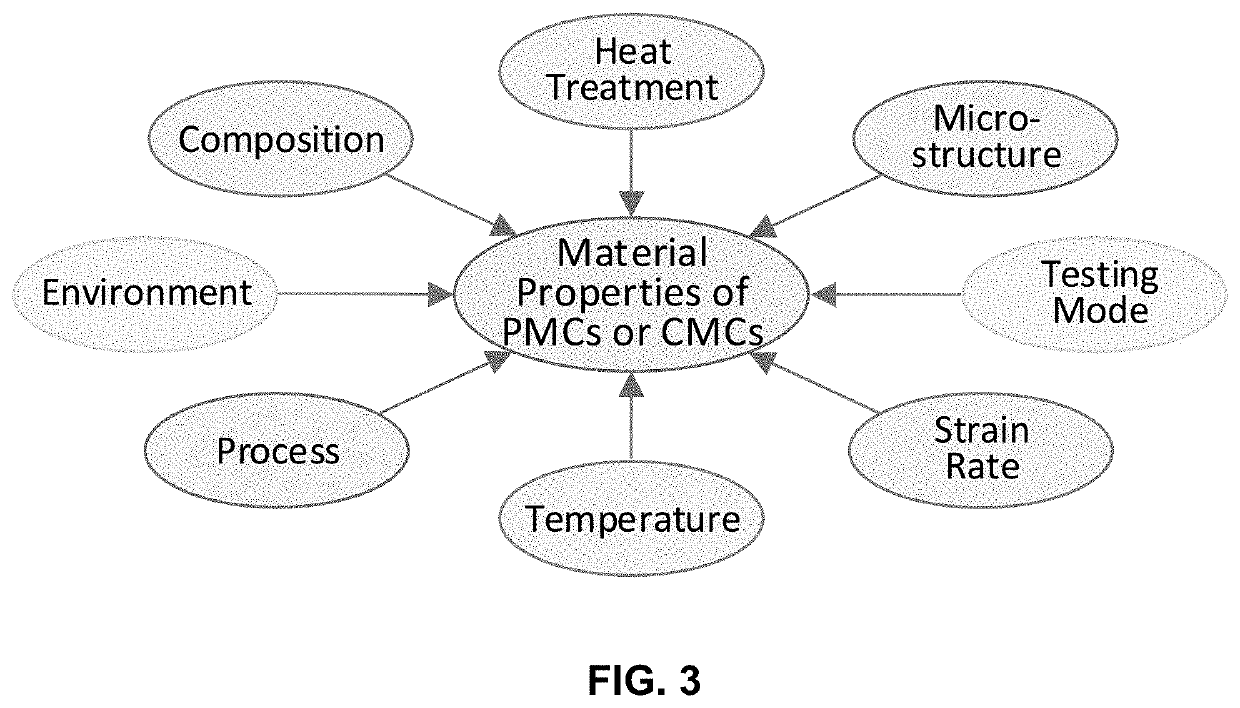Machine Learning to Accelerate Alloy Design
a technology of alloy design and machine learning, applied in machine learning, 3d object support structures, computer peripheral equipment, etc., can solve the problems of inability to predict the experimental definition of multi-component phase diagrams is impractical, and the inability of existing toolsets for icme to predict the effect of am on the material properties of additively manufactured parts
- Summary
- Abstract
- Description
- Claims
- Application Information
AI Technical Summary
Benefits of technology
Problems solved by technology
Method used
Image
Examples
example 1
6. Prediction of Fatigue Endurance Limit
[0360]The overall methodology for predicting the fatigue resistance is presented in FIG. 22. This is a two-stage prediction process, where we first determine the tensile strength, given an input combination, and then determine the fatigue resistance, given the tensile strength and the inputs.
[0361]FIG. 26 compares the high-cycle fatigue properties of HEAs to those of conventional alloys. The HEAs seem to generally result in higher UTS and endurance limits, compared to conventional alloys. Still, there is a lot of scatter in the data. But despite the scatter, the endurance limit seems primarily correlated with the UTS. Hence, by identifying compositions with larger UTS, one can expect greater fatigue resistance. A key to accurate prediction entails understanding, and properly accounting for (explaining), the sources of variations in the data.
[0362]The scatter in the data is caused by input sources, such as defect levels, process parameters, or...
example 3
8. Prediction of Fatigue Life (Stress Life or Strain Life) and Crack Growth
8.1 Prediction of Fatigue Life Remaining (S / N Curve), in Presence of No Cracks
1. Objective
[0412]For the triplet
(process,stress applied,cycles to failure), (34)
the goal is to accurately infer the “process” parameter from the combination
(stress applied,cycles to failure), (35)
in order to properly differentiate between “process” categories.
[0413]Similarly, we can look to estimate “cycles to failure” (fatigue life) from the combination (process, stress applied), or “stress applied” (fatigue strength) from the combination (process, cycles to failure).
2. Method
[0414]The method, presented in FIG. 36, is analogous to the method used for prediction of the endurance limit (see Eq. (16)-Eq. (19)). The main difference is that here we are taking the stress applied as an additional input parameter. The method will be essentially the same as for predicting the endurance limit, except here we are doing separate prediction...
example 4
9 Towards Corrosion Resistant Coatings—Analysis of CMAS and Calcium Sulfate Attacks
9.1 Overall Picture
[0422]This invention can utilize literature materials data or experimental data to develop models or algorithms for machine learning (ML) that will detect data patterns and characteristic trends, learn from the accumulated data, and evolve distinguishing characteristics between calcium-magnesium-alumino-silicate attack (CMAS) and calcium sulfate (CaSO4) hot corrosion, with and without the influence of sea salt, in order to develop resistant coatings to CMAS and calcium sulfate hot corrosion. FIG. 33 presents corrosion data analytics in context with the overall effort to identify high-risk areas for deposit build-up in gas turbines.
[0423]We seek to link structure and chemistry to observed reaction mechanisms to accelerate materials design for corrosive environments.
[0424]The intent is to develop sophisticated physics-based prediction models from experimental data.
[0425]The depositio...
PUM
| Property | Measurement | Unit |
|---|---|---|
| temperatures | aaaaa | aaaaa |
| temperatures | aaaaa | aaaaa |
| composition | aaaaa | aaaaa |
Abstract
Description
Claims
Application Information
 Login to View More
Login to View More - R&D
- Intellectual Property
- Life Sciences
- Materials
- Tech Scout
- Unparalleled Data Quality
- Higher Quality Content
- 60% Fewer Hallucinations
Browse by: Latest US Patents, China's latest patents, Technical Efficacy Thesaurus, Application Domain, Technology Topic, Popular Technical Reports.
© 2025 PatSnap. All rights reserved.Legal|Privacy policy|Modern Slavery Act Transparency Statement|Sitemap|About US| Contact US: help@patsnap.com



